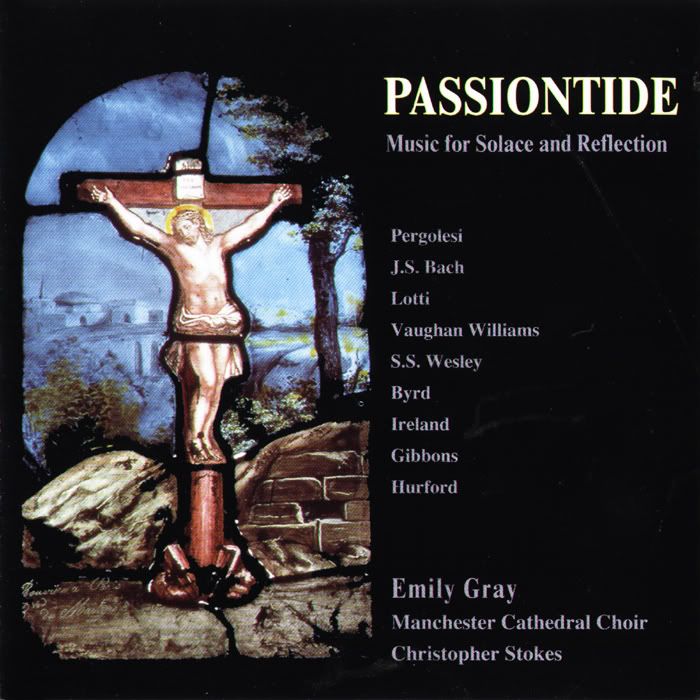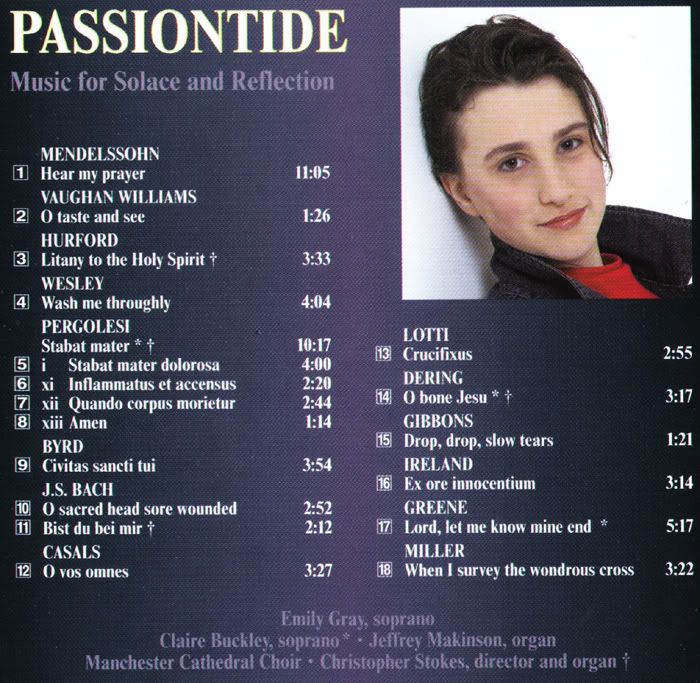 |
| NetLab · Rules · Torrent Tracker · Have a problem? · Eng/Rus |
 Help Help
 Search Search
 Members Members
 Gallery Gallery
 Calendar Calendar
|
| Welcome Guest ( Log In | Register | Validation ) | Resend Validation Email |
|
Posted: 04-01-2011, 22:44
(post 1, #999750)
|
||||||||||||||||||
|
Pro Member Group: Members Posts: 695 Warn:0% |
Passiontide Music for Solace and Reflection Label: Naxos, 8.557025 Year: 2002 Performers: Emily Gray - soprano Claire Buckley - soprano Jeffrey Makinson - organ Manchester Cathedral Choir Christopher Stokes - director and organ Tracklist: Felix Mendelssohn 01. Hear my prayer Ralph Vaughan Williams 02. O taste and see Peter Hurford 03. Litany to the Holy Spirit Samuel Sebastian Wesley 04. Wash me throughly Giovanni Battista Pergolesi Stabat mater 05. Stabat mater dolorosa 06. Inflammatus et accensus 07. Quando corpus morietur 08. Amen William Byrd 09. Civitas sancti tui Johann Sebastian Bach 10. St Matthew Passion, BWV 244: O sacred head sore wounded (O Haupt voll Blut und Wunden) Johann Sebastian Bach 11. Anna Magdalena Notenbuch (Clavier - Buchlein III): Bist du bei mir, BWV 508 (attrib. G.H. Stolzel) Pablo Casals 12. O vos omnes Antonio Lotti 13. Crucifixus a 8 Richard Dering 14. O bone Jesu Orlando Gibbons 15. Drop, drop slow tears John Ireland 16. Ex ore innocentium Maurice Greene 17. Lord, let me know mine end Edward Miller 18. When I survey the wonderous cross Total Playing Time: 01:02:17 The forty days of Lent, which represent the time that Jesus was tempted in the wilderness, have been used by Christians down the ages as a time for reflection, a period in which to repent for sins committed. Lent is also a time to consider God’s plan of salvation for all humans through the events of Good Friday and Easter Day, which end the period of fasting. Like Christmas, Lent and Passiontide have provided composers from every generation with a wealth of material to set to music, either drawn from the Bible or associated, directly or indirectly, with the themes of penitence and the suffering of Christ on the cross. In 1844 Felix Mendelssohn composed Hear my prayer, based on the first seven verses of Psalm LV. The psalmist, in fear of the enemy and the troubles around him, pleads with God to hear his prayers and save him. His desire is to have the wings of a dove by which to escape. The anthem opens with a slow plea from the solo soprano, after which the choir joins the soloist as the music becomes more agitated to reflect ‘the enemy shouteth’, ‘the wicked oppress me’, interspersed with the pleading ‘O God hear my cry’. The gentle soprano solo ‘0 for the wings of a dove’ follows and is developed with the choir to bring the anthem to its peaceful conclusion. The twentieth-century English composer Ralph Vaughan Williams set to music the words of verse 8 of Psalm XXXIV, ‘Otaste and see, for the coronation of Queen Elizabeth 11. The music is direct, allowing the message of this short text to speak clearly. It is often sung at Communion and therefore has a special relevance to Maundy Thursday, with reference to the bread and wine, Christ’s body and blood and the Lord’s open arms waiting to welcome those who turn to him. The Litany to the Holy Spirit by the distinguished English organist Peter Hurford, for many years master of music at St Albans Abbey, is a simple prayer, set for unison voice and keyboard accompaniment, asking for comfort and help from the Holy Spirit when temptations and fears threaten to overwhelm. Samuel Sebastian Wesley composed Wash me throughly using words from Psalm LI. The opening treble solo requesting forgiveness is repeated by the full choir before the separate voice parts enter one by one with the words ‘for I acknowledge my faults’, as if to emphasize the importance of this action before being eligible to receive forgiveness. The Stabat mater is a Latin devotional poem, ascribed to Jacopone da Todi, who died in 1306. It tells of the vigil of Mary by the cross. The early eighteenth century Italian composer Pergolesi is one of many composers who have set this to music and his version was originally scored for two solo voices and strings, quickly winning wide favour. The four movements selected for this recording show first the mourning and anguish felt by Mary in Stabat mater dolorosa (There stood the mournful mother), followed by Inflammatus et accensus (May I, inflamed and burning), Quando corpus morietur (When the body shall die) and the final Amen, bringing the hope that on the Day of Judgement, Mary may intercede for mankind. William Byrd was one of the greatest and most prolific of the Tudor composers. Civitas sancti tui (The City of thy saint) is the second part of his anthem Ne irascaris, Domine (Be not angry, O Lord) and in its English version is ‘Bow thin ear, O Lord’. It is a penitential anthem based on Psalms LXXXVI (v. 1), LXXXV (v. 4) and Isaiah 64 (v. 10). As a result of sin, Zion and Jerusalem have become desolate and destroyed and the people are asking God to have mercy and forgive them for their sins. Byrd’s music conveys the sentiment of the text very effectively and reveals his mature style of composition. O sacred head sore wounded is one of the best known of Johann Sebastian Bitch’s chorales. The words originate from a Latin poem attributed to St Bernard and were translated into German by Paul Gerhardt in 1656 and subsequently into English. It summarizes the suffering of Christ for our salvation and our great indebtedness to him. The melody by the late sixteenth century German composer Hans Leo Hassler is heard in Bach’s fine harmonization. The aria Bist du bei mir (Be thou with me) is one of a group of songs to be found in a music-book copied for the second wife of Johann Sebastian Bach. Anna Magdaleno. Once thought to be by Bach himself, it has more recently been attributed to Bach’s admired contemporary, Gottfried Heinrich Stolzel. Its words, while not directly connected with Lent or Passiontide, show that through the death and resurrection of Christ comes salvation and eternal life, and for those who claim this, death no longer holds its fear. The music, in its serenity, reflects the peace of mind that this knowledge brings. O vos omnes (All ye who pass by) was written around 1932 by the great Catalan cellist Pablo Casals for tenors and basses. but then rearranged for mixed choir in 1965. The words are from Lamentations I (v.12) and Casals’ setting captures the sorrow Jesus must have felt looking down from the cross, and the frustration which breaks out with the words ‘behold me and see and consider...’. The Venetian Antonio Lotti’s Crusifixus, part of a Mass setting, is taken from the Creed. A comparatively short piece, it is, nevertheless, full of great intensity from its opening gradual build up of the voice parts, with some dissonance as if to emphasize Christ’s agony through to the reiteration of his suffering under Pilate and then his death. Rather than ending in the minor key in which the piece is written, the last chord moves to the relative major, as if to stress the positive outcome of Christ’s suffering. The English composer and organist Richard Dering (or Deering), a Catholic convert, lived and worked in Italy and Brussels for some years, returning to London in 1625 in the service of Queen Henrietta Maria. His early Anglican music was followed by compositions in an ltalianate style, under the influence of Monteverdi and his contemporaries. O bone Jesu (O good Jesus), published in Antwerp in 1617, is a prayer of supplication asking for Jesus to show mercy on the sinner. Orlando Gibbons, organist of Westminster Abbey and of the Chapel Royal until his death in 1625, was recognized as one of the best composers of his day. He set to music, the words Drop, drop, slow tears, and a short three-verse poem by Phineas Fletcher. Though David Stowe short, the work shows Gibbons mastery in his interpretation of the text, the theme of the poem reaffirms that the confession of sins should be made with real sincerity and that Jesus prefers to see tears of repentance rather than sin in our eyes. It is also a reminder that Jesus wept over Jerusalem and the sins of the world on Palm Sunday. Ex ore innocentium (From the mouth of the innocent), composed by John Ireland in June 1944 sets Bishop William Walsham How’s poem It is a thing most wonderful. Whilst a dynamic spiritual force from the middle of the nineteenth century, Bishop How enjoyed the simple things in life and his enthusiasm for working with children led him to write this children’s poem about God’s act of great love for mankind. John Ireland’s sensitivity to words enabled his setting to reinforce the simplicity of the text. The opening two verses start in the major key with the understanding that God sent his Son ‘to die to save a child like me’, as well as for ‘those who loved him not’. A change to the minor key reflects on Christ’s death on the cross before the music returns to the major key, describing the inextinguishable love of God and the response that this may bring from the individual. Psalm XXXIX provided the text for the early eighteenth century English composer Maurice Greene’s anthem Lord, let me know mine end. The psalmist recognizes the brevity and uncertainty of life, the sinfulness of man and the need to live a life pleasing to God, as this is his only hope. This beautiful and sincere anthem contains expressive and effective contrapuntal vocal parts over an organ accompaniment, a rarity in its day. The duet for treble voices in the middle of the piece finds the two voices interlacing and changing position as they consider the futility of man’s desires. When I survey the wondrous cross by Isaac Watts, to the tune Rockingham, is one of the most popular of Passiontide hymns. It challenges us to meditate on the cross and to understand the immense love that was shown by Christ in his suffering and death.  
This post has been edited by kgkk on 04-01-2011, 22:46 |
||||||||||||||||||
|
|||||||||||||||||||


Powered by Invision Power Board v1.3.1 Final.

